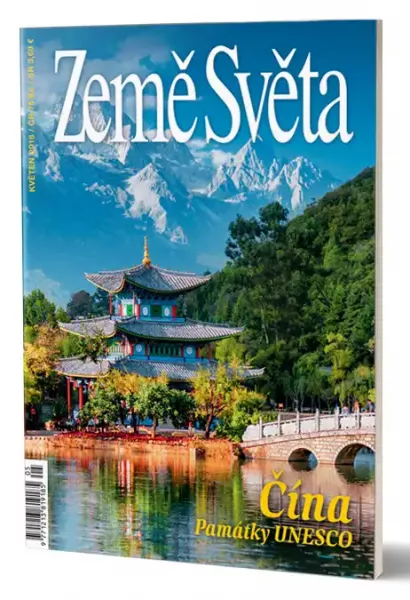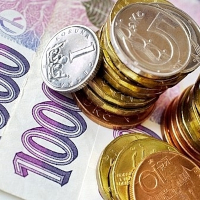Goods in action
Need help choosing,
advice on transport or payment?
Use the chat or contact form.
We will be happy to help you.
We deliver throughout the European Union.


| List Number: | 12390 |
| EAN: | 9771213819185 |
| Warranty: | |
| Manufacturer: | GeoBohemia |
| Price excluding VAT: | 2,50 € |
China has long been referred to as the Middle Kingdom, Chung-kuo, a kingdom that, thanks to their favor, lies directly under the circular heavens in the middle of the square earth. Today, a different designation would be appropriate for it - the Empire of Monuments...
No other country in the world, with the exception of Italy, has as many monuments inscribed on the UNESCO World Heritage List as China. The lead of Italy is very tight, the current score has stopped at a ratio of 53:52, which can easily turn around soon. On the so-called provisional list, in which each country lists monuments it is considering inscribing in the future, China has 60 entries, while Italy only has 41. Sticking to sports terminology, China had a bit of a late start, with its first six monuments on the prestigious list was entered in 1987 (although everything is relative - it was still five years earlier than the first Czech monuments), but then it picked up a sharp pace. Between 1990 and 2017, there were only four years in which not a single new Chinese monument was added to the list. And so we arrive at the current state, which includes 36 cultural, 12 natural and four mixed (cultural and natural) monuments.
Chinese UNESCO monuments are very diverse. This was already indicated by the opening six, which included well-known places as well as localities almost unknown to the wider public. Perhaps everyone has heard of the Great Wall, the Forbidden City or the clay army of the first Chinese emperor and seen these monuments at least in some photographs. The Great Wall, the Long Wall in Chinese, is one of the most widespread symbols of China. And although it is apparently not visible to the naked eye from orbit, as has often been claimed about it in the past (the conjecture on this topic is endless), no other work of human hands on Earth can match it in terms of monumentality. The Great Wall has a history of more than 2,300 years, the vast majority of sections still preserved today come from the construction created during the Ming Dynasty, when the entire wall, including the incorporated natural defense barriers, measured over 8,800 km. More than 20% of the wall has disappeared irretrievably, large parts are in various stages of decay, but it still remains, especially in the maintained and repaired sections north of Beijing< /a>, enough of a wall to appreciate its exceptionality.
The Mausoleum of the First Emperor of Qin, as the official name of the monument, famous above all for its endless rows of clay soldiers, has become closer to the public in many countries thanks to traveling exhibitions with faithful replicas of selected originals. Even if such an exhibition, which was also on display in our country a few years ago, cannot compare to the experience of a real mausoleum, it will do a lot to spread general awareness of the monument. Equally famous is the Beijing residence of the emperors of the Ming and Qing dynasties, or the Forbidden City, to which we dedicate this issue together with the lesser-known Qing Palace in Shenyang as a separate article.
But what does Chou-khou-tien say to you, for example? Biologists and anthropologists know the village about 40 km southwest of Beijing, but others seem to be groping. Excavations that began in the 1920s found the remains of a hominid originally described as Sinanthropus pekinensis and commonly known as "Peking Man". The stormy development of knowledge about human phylogeny combined with a lot of new findings in various parts of the world finally transferred it into the wide arms of the species Homo erectus, but this does not reduce the importance of this finding in any way.
At the time of its registration more than 30 years ago, the Buddhist caves of Mo-kao, located in the far northwest of China in Kansu province on one of the routes Silk paths. We covered them in detail in the issue "China 3" (Zéme světa 10/2015). It is one of the three most important Buddhist cave temple complexes in China. Currently, they are all UNESCO monuments - the Lung-men caves near Luo-yang, which we write about in this issue, were registered in 2000, and the Yun-kang caves near Ta-chung a year later. And in 2014, as evidenced again in the article a few pages later, the Silk Roads were also included in the World Heritage List as a cross-border monument including the initial sections of the old trade routes on the territory of China, Kazakhstan and Kyrgyzstan from Luo-yang, respectively. Chang'an to the so-called Tangshan Corridor.
The last of the first six listed Chinese monuments was Mount Tai, or Taishan, in Shandong Province. It is the eastern of the Five Great Mountains, often considered the most important, and was often visited by emperors to perform some of the ceremonies here as bearers of the mandate of heaven and mediators between heaven and earth. A temple complex was therefore built on the mountain, so it is not surprising that this monument was registered as mixed.
Inscriptions of selected monuments continued with the same diversity in the following years. Inscribed in 1990, also as a mixed monument, was Huangshan, "China's most beloved mountain", the place where, according to legend in 747, the long-sought elixir of immortality was found. In 1992, there were also natural monuments for the first time, three at once. In all cases, these are "scenic areas" - Chuanglung and Jiuchaikou Valley (heavily damaged in the 8/8/2017 earthquake and closed since then) are located in Sichuan Province, Wulingyuan Region, which we have selected for this issue to introduce in more detail, in the province of Chu-nan.
One of the well-known areas is the South China Karst, which extends into four different provinces in several locations with a total area of more than 1,750 km2. It was registered for the first time in 2007, seven years later the range of protected areas was expanded. The karst landscape with limestone hummocks jutting out of the complete plain has a dreamlike impression, geographers and geologists use the various types of karst there as a reference standard for describing karst landscapes elsewhere in the world.
One year before the South China Karst, a natural monument directly connected to perhaps the most Chinese of all Chinese symbols – the Giant Panda Reserve – entered the World Heritage List. It is a complex of seven nature reserves and nine landscape parks that cover an area of more than 9,000 km2 in the Qionglai and Jiajin mountains in Sichuan province, west of its capital, Chengdu. . In addition to the fact that about a third of all giant pandas in the wild live here, this area is also a refuge for other rare mammals, such as irbis, clouded sparrow, Chinese langur or red panda, about 360 species of birds live here (including 16 species of pheasants) , of which more than 300 also nest here and is also very valuable botanically. The world of invertebrates is also remarkable, a rarity such as the water beetle Amphizoa davidis considered extinct at one time. With more than 5,000 species of plants, it is one of the most botanically rich areas in the world outside of the tropical rainforest, with more than 100 different species of foam plants growing here, for example.
A natural monument of a completely different type is the Chengdu Fossil Site in Yunnan Province, registered in 2012. In the shales there (known in paleontology as "Maoqianshan"), a huge number of animal fossils have been preserved that inhabited the sea at the beginning of the Cambrian, about 530 million years ago during the so-called Cambrian explosion, when in a relatively short geological time, i.e. within units or at most a few tens of millions of years, the first known representatives of most large groups of multicellular animals that still exist today appeared. The uniqueness of this locality lies in the fact that, in many cases, these are imprints of soft tissues, preserved so perfectly that sometimes even the boundaries between individual cells can be seen.
There is also a wide variety of cultural monuments to choose from - from the Beijing Temple of Heaven or the Summer Palace of the Chinese Emperors (we covered both in detail in the issue about Beijing - Land of the World 3/2008) through the old part of Lijiang, Confucius's birthplace Zhufu or the landscape around the West Lake near Hangzhou to places whose mere names arouse curiosity and stimulate the imagination, whether they are the capitals and tombs of the ancient kingdom of Koguryo in the northeast of present-day China near the border with Korea, the tribal estates of the hereditary rulers of tchu -sʼ in the mountains in the southwest of the country or perhaps the remains of the legendary capital of the Mongol ruler Kublai Khan and later the summer residence of the emperors of the Mongol Yuan dynasty north of the Great Wall, the mythical Shang-tu, also known as Xanadu.
We have also tried to provide a varied selection on the following pages, where we will present ten Chinese monuments from the World Heritage list in detail. Among them are rocky cities and mountains, old monasteries, imperial palaces, legendary Chinese gardens, important land and waterways with historic cities and natural beauties in the vicinity, and even a piece of baroque and classical Europe in the south of China. Come with us to the Realm of Monuments!















